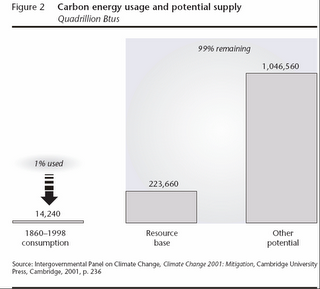Greens wind turbines cause global warming increase
Wind farms can change the weather, according to a model of how these forests of giant turbines interact with the local atmosphere. And the idea is backed up by observations from real wind farms.
Somnath Baidya Roy from Princeton University, and his colleagues modelled a hypothetical wind farm consisting of a 100 by 100 array of wind turbines, each 100 metres tall and set 1 kilometre apart.
They placed the virtual farm in the Great Plains region of the US, an area suitable for large wind farms, and modelled the climate using data from Oklahoma.
During the day, the model suggests that wind farms have very little effect on the climate because the warmth of the sun mixes the lower layers of the atmosphere. But at night, when the atmosphere is stiller, the wind turbines have a significant effect.
“At hub height the turbine gives an extra input of turbulence to the wind, which increases the vertical mixing,” explains Baidya Roy. This brings down to ground level the warm night air and higher wind speeds that are normally found at 100 metres.
At 3 am the average wind speed in Oklahoma is 3.5 metres per second, but it increased to around 5 m/s in the model wind farm. The model also suggested that the temperature would increase by around 2°C underneath the 10,000 turbines. Over the course of a day this averages out to an increase in ground-level wind speed of around 0.6 m/s and a rise in temperature of around 0.7°C.
Heat of the night
How such a change might affect local wildlife and agriculture is not clear.
The findings are backed by real observations. Neil Kelley, a meteorologist at the National Renewable Energy Laboratory in Golden, Colorado, has gathered data from a wind farm in California.
“Although the wind farm was more dense and the turbines smaller we still found that the turbines tended to pull down heat and momentum from above, particularly during the night-time hours,” he says.
Meanwhile, Gustave Corten from the Energy Research Centre in Petten in the Netherlands is carrying out experiments with a model wind farm inside a wind tunnel. “I think the study is of much interest and I can confirm that large wind farms will affect the microclimate,” says Corten.
Baidya Roy says it may be possible to modify the wind turbines so that their effect on the weather is not so extreme. “If engineers can reduce turbulence then the turbine would become more efficient and the environmental impact would be reduced,” he says.
But no amount of engineering will change the fact that energy is being removed from the wind. “People tend to think that renewable energy is for free, but it isn’t. There is a price to pay for all kinds of consumption, including renewable energy,” says Baidya Roy.
Journal reference: Journal of Geophysical Research Atmospheres (DOI: 10.1029/2004 JD004763).
Wind farms can change the weather, according to a model of how these forests of giant turbines interact with the local atmosphere. And the idea is backed up by observations from real wind farms.
Somnath Baidya Roy from Princeton University, and his colleagues modelled a hypothetical wind farm consisting of a 100 by 100 array of wind turbines, each 100 metres tall and set 1 kilometre apart.
They placed the virtual farm in the Great Plains region of the US, an area suitable for large wind farms, and modelled the climate using data from Oklahoma.
During the day, the model suggests that wind farms have very little effect on the climate because the warmth of the sun mixes the lower layers of the atmosphere. But at night, when the atmosphere is stiller, the wind turbines have a significant effect.
“At hub height the turbine gives an extra input of turbulence to the wind, which increases the vertical mixing,” explains Baidya Roy. This brings down to ground level the warm night air and higher wind speeds that are normally found at 100 metres.
At 3 am the average wind speed in Oklahoma is 3.5 metres per second, but it increased to around 5 m/s in the model wind farm. The model also suggested that the temperature would increase by around 2°C underneath the 10,000 turbines. Over the course of a day this averages out to an increase in ground-level wind speed of around 0.6 m/s and a rise in temperature of around 0.7°C.
Heat of the night
How such a change might affect local wildlife and agriculture is not clear.
The findings are backed by real observations. Neil Kelley, a meteorologist at the National Renewable Energy Laboratory in Golden, Colorado, has gathered data from a wind farm in California.
“Although the wind farm was more dense and the turbines smaller we still found that the turbines tended to pull down heat and momentum from above, particularly during the night-time hours,” he says.
Meanwhile, Gustave Corten from the Energy Research Centre in Petten in the Netherlands is carrying out experiments with a model wind farm inside a wind tunnel. “I think the study is of much interest and I can confirm that large wind farms will affect the microclimate,” says Corten.
Baidya Roy says it may be possible to modify the wind turbines so that their effect on the weather is not so extreme. “If engineers can reduce turbulence then the turbine would become more efficient and the environmental impact would be reduced,” he says.
But no amount of engineering will change the fact that energy is being removed from the wind. “People tend to think that renewable energy is for free, but it isn’t. There is a price to pay for all kinds of consumption, including renewable energy,” says Baidya Roy.
Journal reference: Journal of Geophysical Research Atmospheres (DOI: 10.1029/2004 JD004763).

